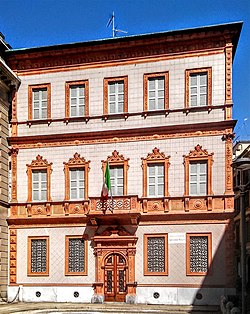Casa Manzoni | |
|---|---|
 The external facade of Casa Manzoni. | |
 | |
| Coordinates: 45°28′04″N9°11′32″E / 45.4679°N 9.1921°E | |
| Country | |
| Region | Lombardy |
| Municipality | Milan |
| Style | Renaissance Revival architecture |
| Construction | 18th century |
| Website | casadelmanzoni.it |
Casa Manzoni ("Manzoni House") is a historical palace sited in via Morone 1 near the quadrilateral of fashion in the center of Milan, Lombardy, Italy, which was where novelist and poet Alessandro Manzoni lived from 1814 until his death in 1873. The building is also the venue of a museum dedicated to his life, the National Center for Manzonian Studies and the Historical Lombard Society.
